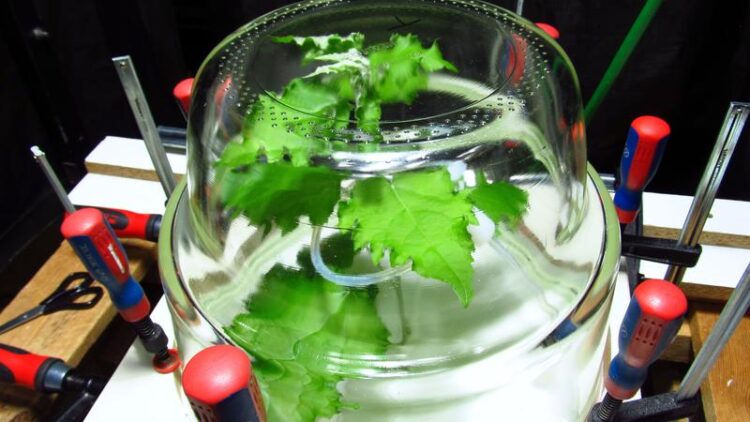Plants protect themselves against self-induced air pollutants

The researchers have studied the gas exchange of young poplars in the laboratory under controlled conditions.
Uni Innsbruck
Trees and other plants release isoprene into the atmosphere. Oxidation processes result in compounds that are harmful to plants. Researchers at the University of Innsbruck have now uncovered a mechanism by which plants protect themselves from these compounds, and have thus discovered an important biogenic source of oxidized volatile organic compounds in the atmosphere.
Plants release large quantities of the hydrocarbon isoprene into the atmosphere, about 600 million metric tons per year, half of which comes from tropical forests. This corresponds approximately to the annual emission of methane on earth. ” It is believed that trees release isoprene to protect themselves from oxidative stress,” explains Armin Hansel from the Department of Ion Physics and Applied Physics at the University of Innsbruck. Together with scientists from Germany, Finland and the USA, his research group has now investigated this interaction between the atmosphere and the plant world more closely.
Plants neutralize Isoprene photooxidation products
In the atmosphere, isoprene released by plants is very quickly converted by photo-oxidation into compounds that are harmful to plants. The Innsbruck scientists exposed young poplars to small doses of these compounds in the laboratory and studied the gas exchange under controlled conditions. For the measurements, the researchers used a specially developed mass spectrometer that can detect even the smallest concentrations of these chemical compounds in air. Similar instruments are distributed by the Innsbruck-based technology company Ionicon Analytik. Such devices were also used on measuring towers in forests in Finland and the USA.
Using the data, the researchers were able to show that trees absorb the harmful compounds into their leaves and convert them into the harmless compound methyl ethyl ketone. By analyzing the leaves from the laboratory experiments at Helmholtz Zentrum München, an enzyme could be identified that is very likely responsible for the detoxification process. “Since this enzyme is found in plants all over the world, we assume that this process is of great global importance,” summarizes Eva Canaval, first author of the research paper now published in the journal Communications Earth & Environment.
Natural source of ketones
Based on these results, scientists at the University of Minnesota have simulated the annual production of methyl ethyl ketone using a global computer model. “These simulations show that plants convert around 1.5 percent of isoprene emitted,” says Eva Canaval. “With about 5.6 million metric tons worldwide, this is the largest known natural source of methyl ethyl ketone.” The measurement data from forests in Finland and the USA confirm this. The researchers suspect that this detoxification process in plants is one of the most important natural sources of oxidized volatile organic compounds in the atmosphere.
The research work at the University of Innsbruck was financially supported by the Federal Ministry of Education, Science and Research and the European Union, among others.
Wissenschaftliche Ansprechpartner:
Eva Canaval
Department of Ion Physics and Applied Physics
University of Innsbruck
Tel.: +43 512 507 52645
E-Mail: eva.canaval@uibk.ac.at
Web: https://www.uibk.ac.at/ionen-angewandte-physik/
Originalpublikation:
Rapid conversion of isoprene photooxidation products in terrestrial plants. Eva Canaval, Dylan B. Millet, Ina Zimmer, Tetyana Nosenko, Elisabeth Georgii, Eva Maria Partoll, Lukas Fischer, Hariprasad D. Alwe, Markku Kulmala, Thomas Karl, Jörg-Peter Schnitzler, Armin Hansel. Communications Earth & Environment 2020 doi: 10.1038/s43247-020-00041-2 (https://doi.org/10.1038/s43247-020-00041-2)
Media Contact
All latest news from the category: Life Sciences and Chemistry
Articles and reports from the Life Sciences and chemistry area deal with applied and basic research into modern biology, chemistry and human medicine.
Valuable information can be found on a range of life sciences fields including bacteriology, biochemistry, bionics, bioinformatics, biophysics, biotechnology, genetics, geobotany, human biology, marine biology, microbiology, molecular biology, cellular biology, zoology, bioinorganic chemistry, microchemistry and environmental chemistry.
Newest articles

NASA: Mystery of life’s handedness deepens
The mystery of why life uses molecules with specific orientations has deepened with a NASA-funded discovery that RNA — a key molecule thought to have potentially held the instructions for…

What are the effects of historic lithium mining on water quality?
Study reveals low levels of common contaminants but high levels of other elements in waters associated with an abandoned lithium mine. Lithium ore and mining waste from a historic lithium…

Quantum-inspired design boosts efficiency of heat-to-electricity conversion
Rice engineers take unconventional route to improving thermophotovoltaic systems. Researchers at Rice University have found a new way to improve a key element of thermophotovoltaic (TPV) systems, which convert heat…



